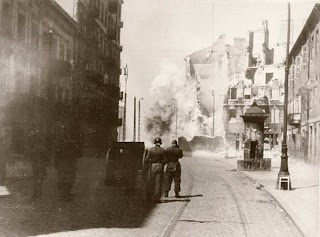 75 years ago this week, German soldiers entered the Warsaw ghetto, intending to deport its remaining Jewish population to Treblinka, a nearby extermination camp. In the months before Passover, there was a halt on deportations due to earlier failed attempts to deport Jews that were met with gunfire and resulted in casualties. However, the Germans and their collaborators returned on the eve of Passover, hoping this time to clear the ghetto of its inhabitants in three days.
75 years ago this week, German soldiers entered the Warsaw ghetto, intending to deport its remaining Jewish population to Treblinka, a nearby extermination camp. In the months before Passover, there was a halt on deportations due to earlier failed attempts to deport Jews that were met with gunfire and resulted in casualties. However, the Germans and their collaborators returned on the eve of Passover, hoping this time to clear the ghetto of its inhabitants in three days.Instead, the Germans were met again with fire and bullets. Sparsely armed with a handful of handguns and Molotov cocktails, the Jewish resistance - led by Mordechai Anielewicz - repelled the initial German assault, killing German soldiers and setting fire to armored vehicles. Though the Germans returned better organized and under the leadership of a different officer, the resistance held out for several more days. In the end, only a few dozen fighters managed to escape the ghetto through the sewers as the Germans and their collaborators systematically destroyed the entire ghetto with fire and explosions.
The legacy of the Warsaw Ghetto uprising, during which approximately 750 Jews fought off Nazi invaders longer than the entire country of France, stands as a testament to the strength of human determination and an example to all. In 2013, the Polish government dedicated the Museum of the History of Polish Jews, which stands on the site of the Warsaw ghetto.
For more on the Uprising and its aftermath - as well as the 2013 commemorations of the event - please see:
- An article in The Economist about ghetto fighter Simcha Rotem, aka 'Kazik'
- Article about the 2013 commemorations on Huffington Post
- New York Times op-ed piece
- Mila 18 - a novel about the uprising by Leon Uris
- Finally, articles about the uprising on Wikipedia and USHMM.







